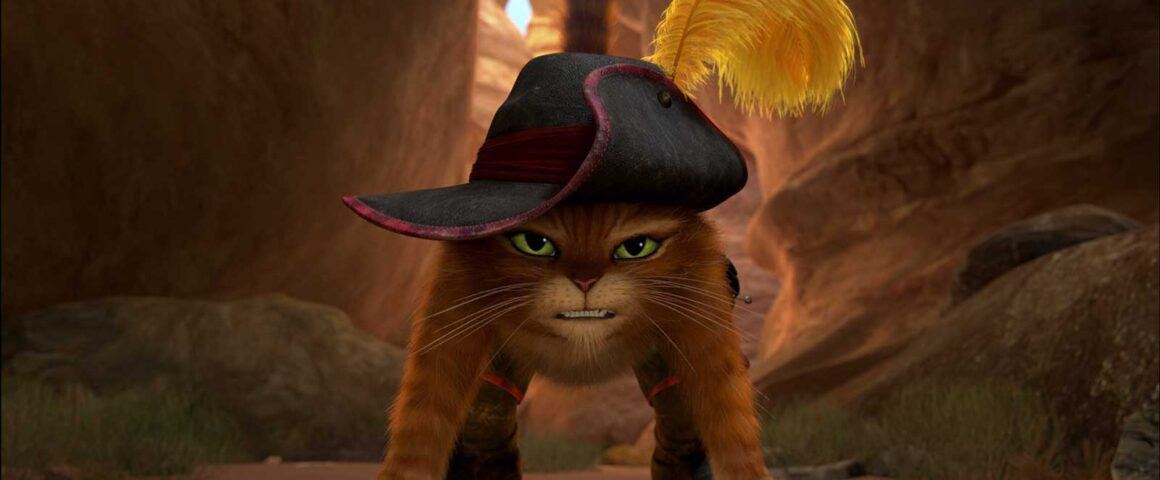It’s the good, the bad, and the catty in Chris Miller’s Puss in Boots, the first action-packed spinoff of the Shrek series, and to the surprise of many, it not only provides viewers a much needed history lesson by explaining how everyone’s favorite swashbuckling orange tabby came to be the legend he is today, but also serves as a largely entertaining action romp for children and adults alike. We learn that before donning his trademark sword, leather mukluks, and feathered cap, Puss (Antonio Banderas) was abandoned in the small village of San Ricardo, where he was eventually taken in and raised by a woman named Imelda (Constance Marie), who ran an orphanage. There, he befriended Humpty Alexander Dumpty (Zach Galifianakis), a dreamer and born inventor who dreamt of locating magical beans rumored to transport their owner to the castle of a giant when planted. Unfortunately, his quest was fruitless and the duo resorted to a life of crime, before being torn apart during a botched robbery. Now, several years later, the loud-mouthed Jack (Billy Bob Thornton) and Jill (Amy Sedaris) become the ruthless outlaws searching for the same legumes and a mystical goose said to be hiding inside the citadel, leaving our titular protagonist no choice but to team up with his former partner and his furry accomplice, a skilled thief and natural-born seductress named Kitty Softpaws (Salma Hayek), to stop them.
Admittedly, despite always being a fan of the character, having two kitties of my own is what sold me on Puss in Boots. If you’ve ever owned a cat (or at least know someone who has), you’d know that they’re incredibly amusing to watch. Sure, they spend most of their time asleep or staring aimlessly at the ceiling, but the times they are awake, hilarity soon follows. That being said, most of the jokes are directed at the natural instincts of a feline; everything from the milk drinking to the light chasing is parodied. For many, this brand of humor will be a lot more approachable than that of the Shrek series, which relied mostly on pop-culture references (although, there are still a few of those sprinkled in). Adults are also rewarded with PG-13 edginess, as the script subtly hints at medical marijuana, and inappropriate tattoos — references that remain completely inconspicuous to children.
Some may find the transition from a stellar performance in Almodovar’s art-horror, “The Skin I Live In,” to an animated blockbuster such as this awkward of Banderas, but upon further reflection it seems like Puss and Robert Legard have more in common than meets the eye (save for the whole “obsessed scientist” shtick). They’re both incredibly charming, ferocious in the own right, and played masterfully by the Spanish export. And in spite of never really being on camera, it’s clear that the actor had fun and enjoyed Hayek’s company (then again, what man wouldn’t?). This is directly reflected in not just the chemistry between Puss and Softpaws, but also Banderas’ willingness to attend a screening of the film surrounded only by cats (as part of a viral marketing event).
Visually, the animation is stunning. There are a lot of luscious colors here — namely reds, oranges, and browns (to accurately reflect the Western appeal) — and the character models are nice to look at. Personally, the highlight of my experience was a prolonged dance-off between Puss and Softpaws. Yet what I wouldn’t recommend would be paying extra for the 3D gloss-over. It’s certainly alluring at some points, but, for the most part, the added cost would serve more of a purpose if it were to be allotted towards food and drinks (all that cartoony razzle-dazzle is sure to do a number on your appetite).
Be that as it may, there are a few more bumps along the road. Written by Brian Lynch, David H. Steinberg, Tom Wheeler, and Jon Zack, Puss in Boots may have a lot of style but, ultimately, it has little substance. Starting off strong by introducing our eponymous hero as Sergio Leone (whom served as an obvious inspiration for the filmmakers) would one of his headliners, the film begins to lose steam by its third act, still offering picturesque visuals but with only a thinning narrative to accompany them. It’s during these final moments that Dumpty becomes the focal point of the story, ushering in some of the movie’s darker themes (such as betrayal and greed). But, thanks to its overt cuteness, these never become too depressing, preachy, or distracting. The same, however, can’t be said about Galifianakis’ grating voice work — no amount of whiskers can compensate for his obnoxious, high-pitched ramblings.
Nevertheless, while Puss in Boots may not be purr-fect, the ample amount of cat-based humor and the charisma that Banderas bestows in his character are more than enough to leave audiences satisfied.




'Movie Review: Puss in Boots (2011)' has no comments